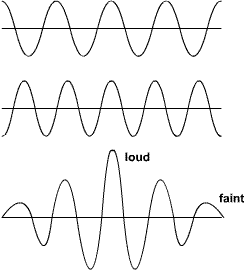beats

A turboprop airplane with twin propellers throbs and drones its way across the sky. The sound is heard by someone standing on the ground. Sound is reaching the listener's ears in pulses which periodically gather strength, die away, and gather strength again.
The engines of the plane are not working in spasms. They have to work all the time and each engine gives out a continuous note. But the two engines are not quite 'in tune' with each other. One is giving out a note of slightly higher frequency than the other. The two lots of sound interfere with each other and the result is heard as a pulsating noise.
This pulsating effect is only heard when the two interfering sources have very similar frequencies. One sound could be middle C. The waves leaving the source have a frequency of 256 cycles per second. No human brain can detect a note rising and falling 256 times each second. The sound is heard as a pure unwavering note. The other note might be lower in pitch – its frequency, say, is 252 cycles per second. On its own, this too is heard as an unwavering note. But together the two make a sound which pulsates.
The two sets of waves start out in phase. They add together and the sound is loud. By the time an eighth of a second has passed they are completely out of step and the intensity drops. Another eighth of a second later when they are back in step again the volume surges up again. There is a frequency difference of four cycles per second and there are four pulses or beats each second. These beats are far enough apart to be heard.
When the second source has its frequency raised to 254 cycles per second, there is a difference of only two cycles per second. Now a quarter of a second has to pass before the sound drops and another quarter of a second before the next pulse of sound. There are two beats per second.
As the two vibrating objects approach the same frequency, the beats grow further apart. The rise and fall in intensity takes place much more slowly. Then when the intensity is completely without variation the two notes match.
Beats are used in this way when a musical instrument is being tuned. A piano goes out of tune because the key which holds a wire in tension slips. Whenever the tension is released, the note changes. First of all the piano tuner must adjust the tension of middle C so that it gives out the correct note. The the rest of the piano can be tuned by comparison with this note. A tuning fork is used because its frequency is chosen to coincide with the correct middle C for a piano. When the prongs of the tuning fork are struck and its held base on a solid surface, it gives out a note. The piano tuner plays middle C which is slightly out of tune with the tuning fork and beats are heard. The tension key is then adjusted until the beats grow further and further apart and gradually disappear. When there are no beats the two frequencies are the same, and that particular note has been tuned.


